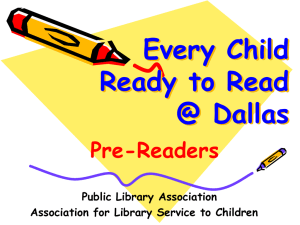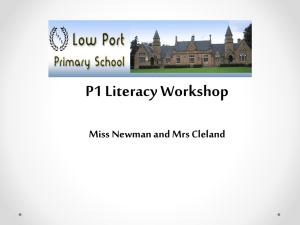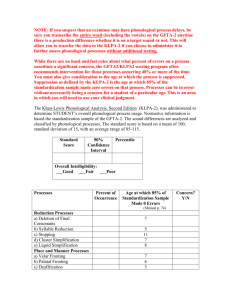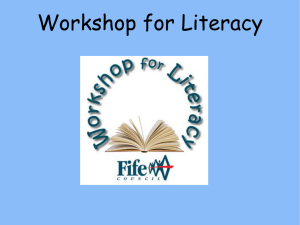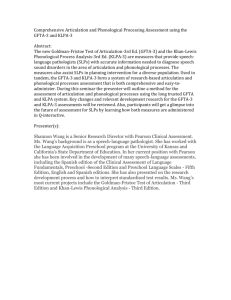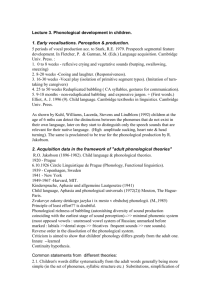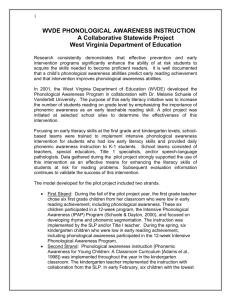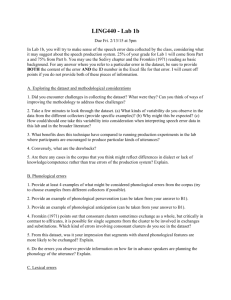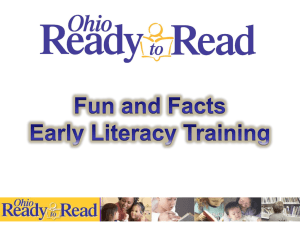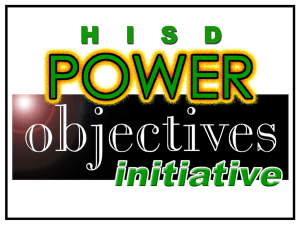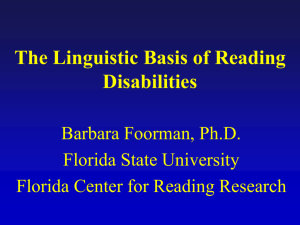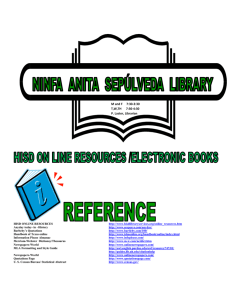Scanner
advertisement
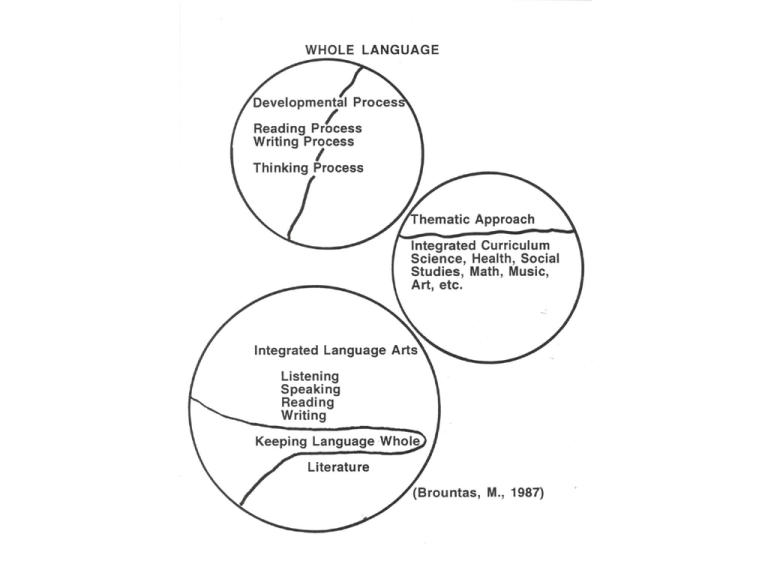
WHOLE LANGUAGE
Refers to an approach--not a program. Listening, speaking, reading, and
writing are presented as an integrated whole. Children are challenged to
take risks in using language for a purpose.The teacher always moves
from the whole rather than the part. Skills are not taught in isolation,
but in context of language that is real. Therefore, literature is a vital
focus in whole language teaching. It is used to expand students'
vocabularies and to give them words and patterns they need to express
their feelings and thoughts to others. There is a natural integration with
other areas of the curriculum such as math, social studies, science, and
music. Emphasis is placed on developing the thinking processes such as
organizing information for speaking and writing, making predictions,
and making inferences. These processes are essential for preparing the
ESL student to develop readiness to enter the mainstream curriculum.
Curriculum Guide for ESL.
Alief ISD
Whole Language
•
Commonsense Assumptions
–
Learning proceeds from part to whole.
Whole Language
Principles
1. I.Learning proceeds
from whole to part.
2. Lessons should be 2.Lessons should be
teacher centered learner centered
because learning because learning
is the transfer of is the acti ve con knowledge from the struction of knowteacher to the ledge by the
student. student.
3 .Lessons should pre- 3 .Lessons should
pare .students to have meaning and
function in society purpose for
after schooling. students now.
4 .Learning takes 4 .Learning takes
place as indivi- place as groups
duals practice engage in meanskills and form ful social
habits. interaction.
Whole Language
Commonsense Assumptions
Learning proceeds from part to
whole.
Lessons should be teacher centered
because learning is the transfer of
knowledge from the teacher to the
student.
L.Lessons should prepare students to
function in society after schooling .
Learning takes place as individuals
practice skills and form habits .
Whole Language Principles
1 .Learning proceeds
from whole to part.
2. Lessons should be
learner centered
because learning
is the active con~ struction of knowledge by the
student.
-3.Lessons should
have meaning and
purpose for
students now.
4 .Learning takes
place as groups
.
engage m meanful social
..
InteractIon.
5 .In a second
language, oral
language acquisi tion precedes
the development
of literacy.
6. Learning should
take place in
English to facili tate the acquisi tion of English.
7 .The learning
potential of
bilingual students is limited.
5.In a second
language, oral
and written
language are
acquired simutaneously.
6. Learning should
take place in the
first language to
build concepts
and facilitate the
acquisition of
English.
7 .Learning poten tial is expanded
through faith in
the learner.
(Freeman & Freeman, 1991)
WHOLE LANGUAGE CHECKLIST
I. DOES THE LESSON MOVE FROM THE
GENERAL TO THE SPECIFIC? ARE
DET AILS PRESENTED WITHIN A GENERAL
CONCEPTUAL FRAMEWORK?
2. IS THERE AN ATTEMPT TO DRAW ON
STUDENT BACKGROUND KNOWLEDGE
AND INTERESTS? ARE STUDENTS GIVEN
CHOICES?
3. IS THE CONTENT MEANINGFUL ? DOES
IT SERVE A PURPOSE FOR THE
LEARNERS?
4. DO STUDENTS WORK TOGETHER
COOPERATIVELY? DO STUDENTS
INTERACT WITH ONE ANOTHER OR DO
THEY ONLY REACT TO THE TEACHER?
5. DO STUDENTS HA VE AN
OPPORTUNITY TO READ AND WRITE AS
WELL AS SPEAK AND LISTEN DURING
THE LESSON?
6. IS THERE SUPPORT FOR THE
STUDENTS' FIRST LANGUAGE AND
CULTURE?
.
COMPONENT PROCESSES OF LEARNING TO READ
Phonological Awareness
Listening games, rhymes, sentences and words,
syllables, initial sounds (s-and), final sounds (san-d),
phonemic segmentation (s-a-n-d), letter names and
sounds
Kindergarten through grade one--precedes alphabetic
principle--should precede assessment in this area
.Print Awareness
.Alphabetic Awareness
.Orthographic Awareness
.Comprehension
.Practice
(The PEER Program, HISD, 1996)
DEFIN ITIONS
PHONOLOGICAL AWARENESS/PHONOLOGICAL
PROCESSING/PHONOLOGICAL SKILLS
Sensitivity to segments in the speech stream.
Demonstrated by ability to produce and recognize
rhymes, to alliterate, and to segment and blend
words into syllables (e.g., re-pub-lic), onset; rimes
(e.g. c-at); and phonemes--e.g., [ability to segment
medial phonemes and transpose phonemes--e.g.,
play Pig Latin--is reciprocal, with, rather than a
precursor to reading]
PHONEMIC AWARENESS is the ability to deal
explicitly and segmentally with sound units smaller
than the syllable (i.e., phonemes).
(The PEER Program, HISD, 1996)
.
READING
A balanced approach (Honig, 1996) is:
"one that combines the language and literature and
literature rich activities associated with whole language
aimed at enhancing meaning, understanding, and the love
of language with explicit teaching of the skills needed to
develop fluency with print, including the automatic
recognition of a growing number of words and the ability to
decode new words."(p. 2)
.One in five have trouble reading (Shaywitz, Shaywitz,
Fletcher and Esobar, 1990)
all children take what they know about internal
sound structures of words and apply this knowledge to print
(Liberman, Shankweiler, and Liberman, 1989).
Consequently, all children learn to read by sounding out
words regardless of how they are taught. When children
are successful early readers, it is clear that this ski ii is
maximized. When they fail to learn to read, it is clear that
this particular skill does not develop properly (Stanovich,
1986; Vellutino, 1987).
children raised in alternative language
environments may have difficulty learning to decode words
because of differences in dialect or because they had
significant exposure to languages other than the primary
language of instruction. In many of these children, the
problem still revolves around their development of
phonological awareness skillls (Vellutino, 1987).
.Approximately 80 percent of all children served as
learning disabled in the public schools have problems with
reading (Lerner, 1989). Of these cases, it has been
estimated that 90 percent have problems with development
of decoding skills (Lyon, 1995; Lyon and Watson, 1981 ).
(The PEER Program, HISD, 1996)
COOPERATIVE LEARNING
Cooperative Learning is the
structuring of classrooms so that
students work together in small
heterogeneous groups to meet
common learning objectives. Their
contribution to group work results in
group as well as personal
accomplishment. The student
interaction occurring during
Cooperative Learning promotes
academic achievement and positive
feelings about school, teachers, other
students, and self .
SEDL, Spring 1988
ROLE OF TEACHERS IN
COOPERATIVE LEARNING
1. Set instructional objectives.
2. Make decisions relevant to
grouping, room arrangements,
materials, and role assignments.
3. Set tasks and positive
interdependence.
.4. Evaluate learning and group
cooperation.
"It is important to explain that their
role has shifted from transmitters of
knowledge to mediators of thinking."
IDRA NEWSLETTER XVI {9), 1989
PROCESS WRITING
1. Prewriting (preparing, purpose, main idea, details)
.talking, questioning, clustering, reading, journals
2. Drafting (getting ideas on paper)
.fast writing, buddy/dialogue journals, logs
3. Revising (reordering, reviewing)
.peer response groups, show and not tell
4. Editing (correcting grammar, spelling, mechanics)
.peer editing groups, proof reading
5. Publishing (creating classroom library, sharing)
.bulletin boards, school papers, school book fairs
Peregoy & Boyle, 2001
ACTIVE LEARNING
Definition
It refers to the level of engagement by the
student in the instructional process. The teacher
and student share the responsibility for learning.
T heoretical Base
It derives from situated cognition theorists such
as Paolo Freire (instruction is most effective when
situated within a student's own knowledge and world
view), and L.S. Vygotsky's "zone of proximal
development" ( students learn best when new
i nformation presented is just beyond the reach of
their present knowledge) .
Community and Culture
Key elements of the approach come from Luis
Moll's "Funds of Knowledge" model (language
minority students come to school with knowledge
and strengths that should be utilized by
the school).
Students learn content, develop conceptual
knowledge, acquire language through a discovery
oriented approach to learning. The learner is viewed
as responsible for discovering, constructing, and
creating something new--and the teacher is seen as
a resource and facilitator .
V. Fern, K. Anstrom, B. Silcox, Directions in
Language and Education, Vol. 1 (2), NCBE
C'
Freirei (1970, 1973, 1985)
1985)andFreire&Macedo (1987) have argued for a literacy that
makes oppressed communities socially and
pomically conscious about their subservient
role and lowly status in society. The
argument is that literacy must go welt beyond
the skills of reading and writing. It must
make people aware of their sociocultural
context and their political environment. This
may occur through mother tongue literacy,
multilingual literacy ( and local/international
'multiple' literacies of value in differing
contexts) and localllteracies (Street,1984).
(Baker, C. , 1996, p. 308)

